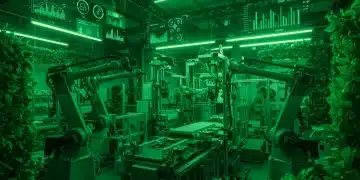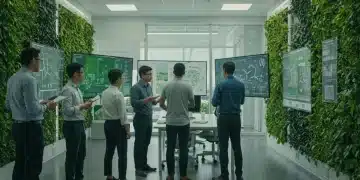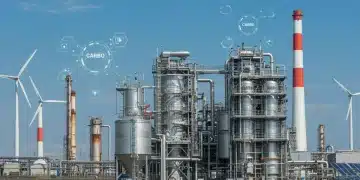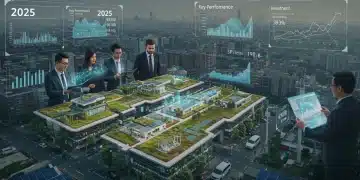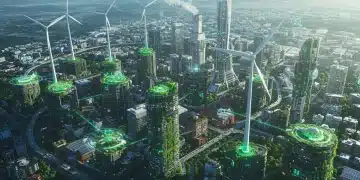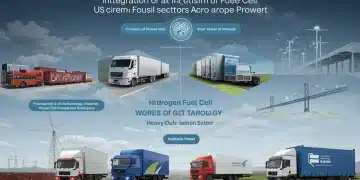Water Conservation Tech: 20% Reduction in US Commercial Use by 2025
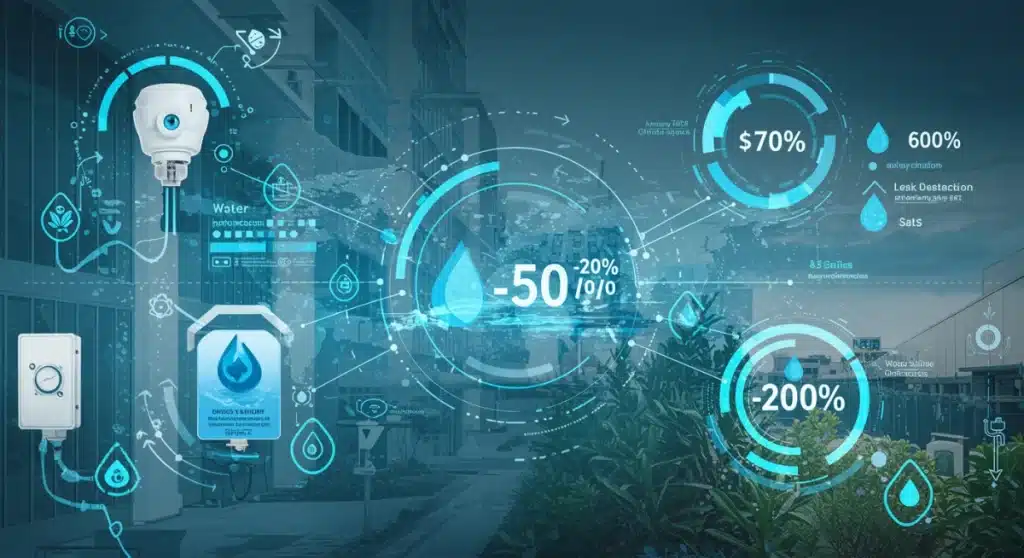
The push for sustainability is accelerating, and at its forefront is the urgent need for water conservation. Water conservation technology is now a critical driver in achieving a projected 20% reduction in US commercial water use by 2025. This ambitious target is not merely an environmental goal; it presents significant practical solutions and substantial financial impacts for businesses.
The Mandate for Commercial Water Reduction
Commercial enterprises across the United States are facing increasing pressure to reduce their water consumption. This mandate stems from a confluence of factors, including escalating operational costs, tightening environmental regulations, and a growing societal demand for corporate responsibility. The 2025 target for a 20% reduction is now a clear benchmark for progress.
Water scarcity is no longer a localized issue; it is a national concern impacting various industries from manufacturing to hospitality. Businesses recognize that proactive measures in water management are essential for long-term viability and competitiveness. Ignoring these trends can lead to significant financial penalties and reputational damage.
Rising Operational Costs and Resource Scarcity
The cost of water and wastewater treatment continues to climb, directly impacting business operating budgets. As regions experience more frequent droughts and water supply limitations, the economic incentive to conserve becomes undeniable. Companies are now actively seeking solutions to mitigate these rising expenses.
- Increased utility bills directly cut into profit margins.
- Drought surcharges and restrictions can disrupt operations.
- The long-term availability of water is a strategic business concern.
Innovative Technologies Driving Efficiency
The landscape of water conservation technology is rapidly evolving, offering a wide array of innovative solutions that cater to diverse commercial needs. These technologies are foundational to achieving the 20% reduction goal, providing businesses with practical tools to monitor, manage, and significantly decrease water usage.
From advanced leak detection systems to smart irrigation, these innovations are making water efficiency more accessible and cost-effective than ever before. Early adopters are already reporting substantial savings and improved operational resilience, setting a precedent for wider industry adoption.
Smart Metering and Leak Detection Systems
One of the most immediate and impactful applications of water conservation technology involves smart metering and sophisticated leak detection. These systems provide real-time data on water consumption, allowing businesses to identify anomalies and pinpoint leaks quickly, preventing significant water loss and associated costs.
- Real-time data analytics for consumption patterns.
- Automated alerts for unusual water flow.
- Early detection of leaks minimizes damage and waste.
These systems are critical for large commercial facilities where a small leak can go unnoticed for extended periods, leading to thousands of gallons wasted. The ability to monitor usage actively empowers businesses to make informed decisions about their water management strategies.
Practical Solutions for Commercial Implementation
Implementing effective water conservation technology in commercial settings requires a strategic approach, focusing on solutions that offer both significant water savings and a strong return on investment. Businesses are now evaluating a range of practical technologies designed to integrate seamlessly into existing infrastructure while delivering measurable results.
From retrofitting older systems to installing entirely new, high-efficiency equipment, the options are diverse. The key is to identify the most impactful areas for intervention based on current water usage patterns and operational requirements.
High-Efficiency Fixtures and Appliances
Upgrading to high-efficiency fixtures and appliances is often the first step for many commercial entities. These include low-flow toilets, waterless urinals, efficient faucets, and ENERGY STAR certified dishwashers and washing machines. These simple changes can lead to substantial daily water savings without compromising functionality.
For example, a restaurant can significantly reduce its water footprint by installing high-efficiency pre-rinse spray valves. Similarly, hotels benefit immensely from low-flow showerheads and toilets in guest rooms. These upgrades also often come with attractive rebates and incentives from local water authorities, further enhancing their financial appeal.
Water Recycling and Reuse Systems
Beyond reducing consumption, many businesses are exploring advanced water recycling and reuse systems. Greywater recycling, for instance, involves treating water from sinks and showers for non-potable uses like irrigation or toilet flushing. In industrial settings, advanced treatment systems can purify process water for reuse, drastically cutting down on fresh water intake.
These systems represent a more significant upfront investment but offer substantial long-term savings and increased water independence, particularly in regions prone to water shortages. The technology for effective and safe water recycling is becoming more sophisticated and accessible.
The Financial Impact and ROI for Businesses
The integration of water conservation technology is not just an environmental imperative; it is a sound financial decision for US commercial entities. Businesses are increasingly recognizing that investments in water efficiency yield tangible returns through reduced operating costs, enhanced resource security, and improved public perception.
The financial benefits extend beyond direct savings on water bills, encompassing potential tax credits, rebates, and even increased property values for buildings demonstrating superior sustainability performance. Analyzing the return on investment (ROI) is crucial for justifying these initial expenditures.
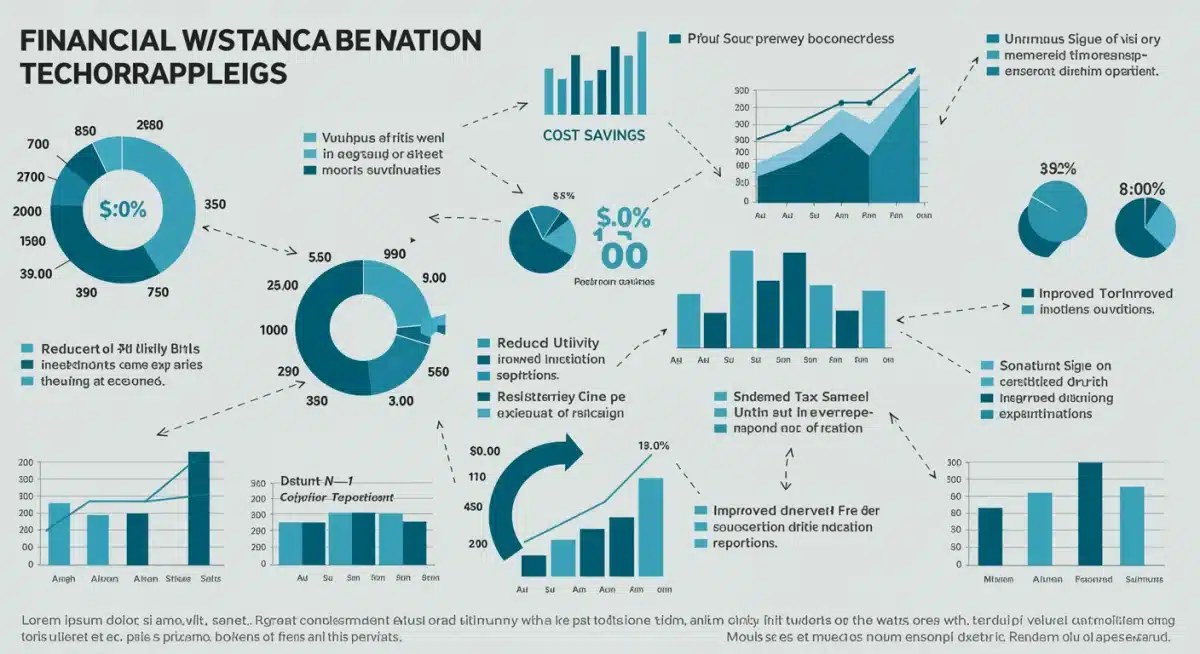
Reduced Operating Expenses
The most direct financial benefit comes from a significant reduction in water utility bills. By consuming less water, businesses immediately lower their monthly expenditures. This saving is often compounded by reduced energy costs, as less water needs to be heated, pumped, or treated.
Furthermore, businesses can often avoid costly surcharges imposed by municipalities during periods of water scarcity. These immediate savings contribute directly to the bottom line, making a strong case for investment in water-saving technologies.
Incentives, Rebates, and Tax Credits
Government agencies and local water utilities frequently offer a variety of incentives to encourage water conservation. These can include rebates for installing high-efficiency fixtures, grants for implementing water-saving landscaping, and even tax credits for adopting advanced water management systems. Businesses should actively research and leverage these programs to offset initial investment costs.
- Local utility rebates for fixture upgrades.
- State and federal tax credits for certain technologies.
- Grants for sustainable infrastructure projects.
Challenges and Overcoming Barriers to Adoption
While the benefits of water conservation technology are clear, commercial adoption faces several challenges. These include initial investment costs, a lack of awareness regarding available solutions, and the complexities of integrating new systems into existing infrastructure. Overcoming these barriers is crucial for widespread implementation and achieving the 20% reduction target by 2025.
Addressing these hurdles requires a combination of education, financial incentives, and supportive policy frameworks. Businesses need clear pathways and resources to make informed decisions and facilitate the transition to more water-efficient operations.
Initial Investment and Perceived Risk
The upfront cost of installing new water conservation technologies can be a significant deterrent for some businesses, particularly small and medium-sized enterprises (SMEs). This perceived financial risk often overshadows the long-term savings and environmental benefits. Financial models demonstrating clear ROI are essential to mitigate this concern.
Moreover, some businesses may be hesitant to adopt new technologies due to concerns about compatibility with current systems or potential disruptions during installation. Pilot programs and case studies showcasing successful implementations can help build confidence.
Lack of Awareness and Expertise
Many commercial property owners and facility managers may not be fully aware of the range of water conservation technologies available or the potential savings they offer. There is often a gap in expertise regarding how to assess current water usage, identify areas for improvement, and select the most appropriate solutions.
- Limited knowledge of available technologies.
- Underestimation of potential water waste.
- Difficulty in quantifying the financial benefits.
Educational initiatives, workshops, and accessible resources are vital to inform businesses about the advantages and implementation processes of water-saving solutions.
Future Outlook and Sustainability
The trajectory for water conservation technology in US commercial sectors points towards sustained growth and increasing sophistication. As the 2025 target draws nearer, the focus will intensify on scalable, intelligent, and integrated solutions that not only reduce water consumption but also contribute to broader sustainability goals. The future promises more interconnected systems, predictive analytics, and a deeper understanding of water’s role in business operations.
This ongoing evolution is critical for building resilient businesses and communities in the face of climate change and increasing demands on natural resources. The commitment to water efficiency is becoming a benchmark for corporate environmental stewardship.
Integration with Smart Building Systems
Future water conservation efforts will increasingly integrate with broader smart building management systems. This convergence will allow for holistic resource management, where water usage is optimized in conjunction with energy consumption, waste management, and air quality. Predictive analytics will play a key role in identifying potential issues before they escalate.
The synergy between different smart systems will create a more efficient and responsive commercial environment, leading to greater overall sustainability and operational savings. This integrated approach represents the next frontier in commercial resource management.
Policy and Regulatory Support
Looking ahead, it is anticipated that policy and regulatory frameworks will continue to evolve to support and incentivize water conservation. This may include stricter building codes for water efficiency, expanded rebate programs, and potentially new mandates for water-intensive industries. Such governmental support will be instrumental in driving further adoption of water-saving technologies.
The collective effort from businesses, technology providers, and policymakers will be essential to meet and exceed future water reduction targets, ensuring a more sustainable future for commercial operations across the nation.
| Key Point | Brief Description |
|---|---|
| 2025 Reduction Target | US commercial sector aims for a 20% decrease in water use by 2025, driven by economic and environmental factors. |
| Key Technologies | Smart metering, leak detection, high-efficiency fixtures, and water recycling systems are crucial for achieving targets. |
| Financial Benefits | Businesses benefit from reduced utility bills, potential tax incentives, and enhanced brand reputation. |
| Adoption Challenges | Initial costs and lack of awareness are barriers, requiring education and financial support to overcome. |
Frequently Asked Questions About Commercial Water Conservation
The main objective is to achieve a 20% reduction in commercial water usage across the United States by 2025. This goal addresses both environmental sustainability and financial efficiency for businesses operating in various sectors.
Key technologies include smart water meters for real-time monitoring, advanced leak detection systems, high-efficiency fixtures and appliances, and water recycling and reuse systems. These innovations provide actionable data and reduce consumption.
Financial benefits include significant reductions in utility bills, eligibility for government rebates and tax credits, and improved public perception as a sustainable enterprise. These contribute to a positive return on investment and long-term savings.
Major challenges include the initial investment costs, a lack of comprehensive awareness among businesses about available solutions, and the complexities involved in integrating new technologies with existing infrastructure. Education is vital.
Government policies and local utility programs are crucial, offering incentives like rebates, grants, and tax credits. They also establish regulations and building codes that encourage or mandate the adoption of water-efficient practices and technologies.
What Happens Next
As the 2025 deadline approaches, the focus on water conservation technology will intensify across all commercial sectors. Expect to see accelerated innovation in smart water management systems and greater integration with broader smart building platforms. Policy frameworks are also likely to evolve, potentially introducing more stringent water efficiency standards and expanded incentive programs. Businesses that proactively adopt these technologies now will be best positioned to meet future regulatory demands, secure operational resilience, and capitalize on significant financial savings in an increasingly water-constrained future.
